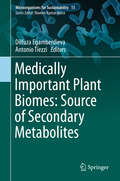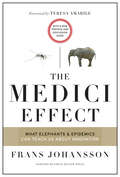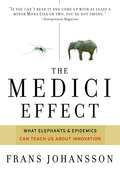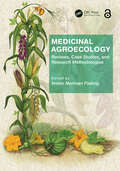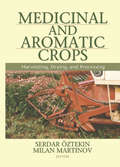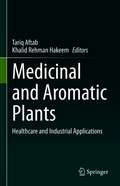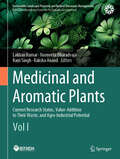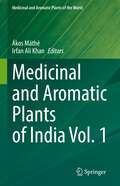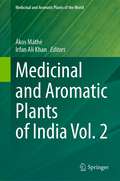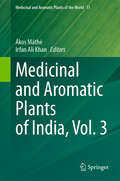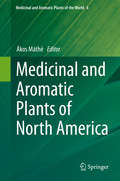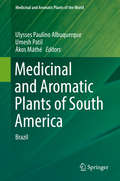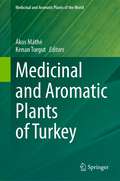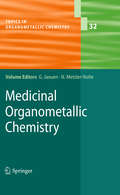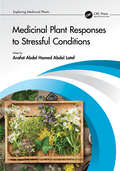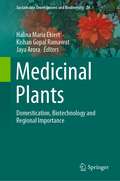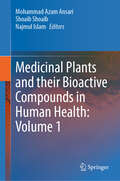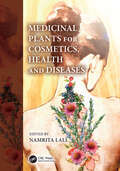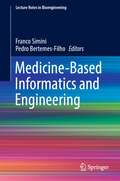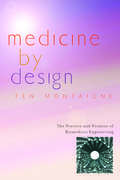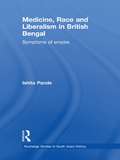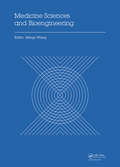- Table View
- List View
Medically Important Plant Biomes: Source of Secondary Metabolites (Microorganisms for Sustainability #15)
by Dilfuza Egamberdieva Antonio TiezziThis book provides insights into various aspects of medicinal plant-associated microbes, known to be a unique source of biological active compounds, including their biotechnological uses and their potential in pharmaceutical, agricultural and industrial applications. Featuring review papers and original research by leading experts in the field, it discusses medicinal plants and their interactions with the environment; medicinal plants as a source of biologically active compounds; medicinal plant-associated microbes (diversity and metabolites); their pharmaceutical, agricultural and industrial applications as well as their potential applications as plant growth stimulators and biocontrol agents. As such the book offers a valuable, up-to-date overview of the current research on medicinal plants, their ecology, biochemistry and associated biomes.
The Medici Effect: What Elephants And Epidemics Can Teach Us About Innovation
by Frans Johansson<p>With Amazon Business, you would have saved $212.15 in the last year. Create a free account and save up to 13% today.</p><p>Why do so many world-changing insights come from people with little or no related experience? Charles Darwin was a geologist when he proposed the theory of evolution. And it was an astronomer who finally explained what happened to the dinosaurs.</p><p>Frans Johansson's The Medici Effect shows how breakthrough ideas most often occur when we bring concepts from one field into a new, unfamiliar territory and offers examples of how we can turn the ideas we discover into path-breaking innovations.</p><p>Clayton M. Christensen, bestselling author of The Innovator's Dilemma, has described The Medici Effect as "one of the most insightful books about managing innovation I have ever read. Its assertion that breakthrough principles of creativity occur at novel intersections is an enduring principle of creativity that should guide innovators in every field."</p><p>Now with a new preface and a discussion guide, and a foreword by Harvard Business School professor Teresa Amabile, The Medici Effect is a timeless classic that will help you reach your innovative peak.</p>
Medici Effect
by Frans JohanssonWhy do so many world-changing insights come from people with little or no related experience? Charles Darwin was a geologist when he proposed the theory of evolution. And it was an astronomer who finally explained what happened to the dinosaurs.Frans Johansson's The Medici Effect shows how breakthrough ideas most often occur when we bring concepts from one field into a new, unfamiliar territory, and offers examples how we can turn the ideas we discover into path-breaking innovations.
Medicinal Agroecology: Reviews, Case Studies and Research Methodologies
by Immo Norman FiebrigMedicinal Agroecology: Reviews, Case Studies, and Research Methodologies presents information on applications of ‘green therapies’ in restoration towards global sustainability. These practices connect the world of medicinal plants with ecologic farming practice, creating a compassionate socio-political worldview and heartfelt scientific research towards food sovereignty and a healthier future on planet Earth. The book communicates benefits of using plant-based solutions to manage the challenges of unsustainable practices in human healthcare, veterinary medicine, agriculture, forestry, and water management. The contributions introduce advances around plants and their active components to potentially treat disease, regulate dysfunction, and balance ecosystems. These practices are explored in further depth through three sections: POLICIES AND FRAMEWORKS, INSIGHTS AND OVERVIEWS, and CASE STUDIES AND RESEARCH METHODS. Edited by Immo Norman Fiebrig, Medicinal Agroecology: Reviews, Case Studies, and Research Methodologies appeals to those in various disciplines including agriculture and agroecology, healthcare, environmental sciences, and veterinary medicine.Chapters 3 and 9 of this book are freely available as a downloadable Open Access PDF at http://www.taylorfrancis.com under a Creative Commons [Attribution-Non Commercial-No Derivatives (CC-BY-NC-ND)] 4.0 license.
Medicinal and Aromatic Crops: Harvesting, Drying, and Processing
by Serdar Oztekin Milan MartinovMake sure your crops are market-ready with the aid of harvest and post-harvest mechanization Medicinal and Aromatic Crops presents harvest and post-harvest mechanization methods for the profitable production of market-ready medicinal crops. This practical handbook includes photos, detailed figures, and schematic drawings of machines tha
Medicinal and Aromatic Plants: Healthcare and Industrial Applications
by Tariq Aftab Khalid Rehman HakeemBefore the concept of history began, humans undoubtedly acquired life benefits by discovering medicinal and aromatic plants (MAPs) that were food and medicine. Today, a variety of available herbs and spices are used and enjoyed throughout the world and continue to promote good health. The international market is also quite welcoming for MAPs and essential oils. The increasing environment and nature conscious buyers encourage producers to produce high quality essential oils. These consumer choices lead to growing preference for organic and herbal based products in the world market. As the benefits of medicinal and aromatic plants are recognized, these plants will have a special role for humans in the future. Until last century, the production of botanicals relies to a large degree on wild-collection. However, the increasing commercial collection, largely unmonitored trade, and habitat loss lead to an incomparably growing pressure on plant populations in the wild. Therefore, medicinal and aromatic plants are of high priority for conservation. Given the above, we bring forth a comprehensive volume, “Medicinal and Aromatic Plants: Healthcare and Industrial Applications”, highlighting the various healthcare, industrial and pharmaceutical applications that are being used on these immensely important MAPs and its future prospects. This collection of chapters from the different areas dealing with MAPs caters to the need of all those who are working or have interest in the above topic.
Medicinal and Aromatic Plants: Current Research Status, Value-Addition to Their Waste, and Agro-Industrial Potential (Vol I) (Sustainable Landscape Planning and Natural Resources Management)
by Ram Singh Navneeta Bharadvaja Lakhan Kumar Raksha AnandDue to complex phytochemical components and associated beneficial properties, numerous medicinal and aromatic plants, in whole or parts, have been used for nutritional purposes or the treatment of various diseases and disorders in humans and animals. Essential oils from medicinal and aromatic plants (MAPs) have been exploited for product formulations of pharmaceuticals, cosmetics, food and beverage, colorants, biopesticides, and several other utility chemicals of industrial importance. There is scientific evidence of many medicinal plant extracts possessing immunomodulatory, immunostimulatory, antidiabetic, anticarcinogenic, antimicrobial, and antioxidant properties, thus demonstrating their traditional use in popular medicine. With the advent of modern technology, the exploitation of natural resources has exponentially increased in order to fulfill the demand of an increased human population with improved quality of life. The traditional agriculture and production-based supply of commodities is inadequate to meet the current demand. Biotechnological approaches are gaining importance to bridge the gaps in demand and supply. In the proposed book, medicinal and aromatic plant-based secondary metabolites have been discussed in terms of their therapeutic potential and industrial relevance. To discuss the qualitative and quantitative analysis of a range of medicinal and aromatic plants-based secondary metabolites (SMs), bioprocess development for their extraction and bioseparation, a brief overview of their industrial relevance, various tissue culturing strategies, biotechnological approaches to enhance production, scale-up strategies, management of residual biomass post extraction of target SMs is central to the idea of the proposed book. A section will explore the verticals mentioned above. In the next section, the book addresses the approaches for conserving and improving medicinal and aromatic plant genetic resources. In the third section, approaches to managing the post-harvest crop residue and secondary metabolites extracted plant biomass will be thoroughly discussed. The recent integration of artificial intelligence to improve medicinal and aromatic plant research at several levels, including the development and employment of computational approaches to enhance secondary metabolite production, tissue culture, drug design and discovery, and disease treatment, will be included in the fourth section. The book summarizes current research status, gaps in knowledge, agro-industrial potential, waste or residual plant biomass management, conservation strategies, and computational approaches in the area of medicinal and aromatic plants with an aim to translate biotechnological interventions into reality.
Medicinal and Aromatic Plants: Current Research Status, Value-Addition to Their Waste, and Agro-Industrial Potential (Vol II) (Sustainable Landscape Planning and Natural Resources Management)
by Ram Singh Navneeta Bharadvaja Lakhan Kumar Raksha AnandDue to complex phytochemical components and associated beneficial properties, numerous medicinal and aromatic plants, in whole or parts, have been used for nutritional purposes or the treatment of various diseases and disorders in humans and animals. Essential oils from medicinal and aromatic plants (MAPs) have been exploited for product formulations of pharmaceuticals, cosmetics, food and beverage, colorants, biopesticides, and several other utility chemicals of industrial importance. There is scientific evidence of many medicinal plant extracts possessing immunomodulatory, immunostimulatory, antidiabetic, anticarcinogenic, antimicrobial, and antioxidant properties, thus demonstrating their traditional use in popular medicine. With the advent of modern technology, the exploitation of natural resources has exponentially increased in order to fulfill the demand of an increased human population with improved quality of life. The traditional agriculture and production-based supply of commodities is inadequate to meet the current demand. Biotechnological approaches are gaining importance to bridge the gaps in demand and supply. In the proposed book, medicinal and aromatic plant-based secondary metabolites have been discussed in terms of their therapeutic potential and industrial relevance. To discuss the qualitative and quantitative analysis of a range of medicinal and aromatic plants-based secondary metabolites (SMs), bioprocess development for their extraction and bioseparation, a brief overview of their industrial relevance, various tissue culturing strategies, biotechnological approaches to enhance production, scale-up strategies, management of residual biomass post extraction of target SMs is central to the idea of the proposed book. A section will explore the verticals mentioned above. In the next section, the book addresses the approaches for conserving and improving medicinal and aromatic plant genetic resources. In the third section, approaches to managing the post-harvest crop residue and secondary metabolites extracted plant biomass will be thoroughly discussed. The recent integration of artificial intelligence to improve medicinal and aromatic plant research at several levels, including the development and employment of computational approaches to enhance secondary metabolite production, tissue culture, drug design and discovery, and disease treatment, will be included in the fourth section. The book summarizes current research status, gaps in knowledge, agro-industrial potential, waste or residual plant biomass management, conservation strategies, and computational approaches in the area of medicinal and aromatic plants with an aim to translate biotechnological interventions into reality.
Medicinal and Aromatic Plants of India Vol. 1 (Medicinal and Aromatic Plants of the World #8)
by Ákos Máthé Irfan Ali KhanThis book is the 8th volume of the popular series ‘Medicinal and Aromatic Plants of the World’. Like the previous volumes, this volume is being introduced in a monographic format containing an extremely rich and diverse medicinal flora of India. Both well-known and somewhat still ignored species have been described in view of their traditional, present day and prospective uses. The scientific and technological achievements are also included aptly in this volume, together with a careful and critical consideration to our contemporary knowledge of this vast interdisciplinary domain with an Indian focus. In the era of global climate change and pandemics, building on the huge Indian traditions, this volume will make an important contribution to the better knowledge and understanding of MAPs. The Indian flora has always been recognized for its medicinal and aromatic plant values and this volume is explicitly focusing in that direction. With the rapidly expanding scope of natural nutraceuticals and herbal formulations, this book will be a fruitful acquisition for the interested readers globally.
Medicinal and Aromatic Plants of India Vol. 2 (Medicinal and Aromatic Plants of the World #9)
by Ákos Máthé Irfan Ali KhanThis book is the 9th volume in the series Medicinal and Aromatic Plants of the World. India being one of the countries with the longest and richest past/present/future of Medicinal and Aromatic Plant (MAP) production and utilization has accumulated more than sufficient knowledge to fill two volumes. This is shown by the vivid interest of Indian colleagues to contribute. Similar to the previous volumes, this one deals with the various important aspects (from botanical through phytochemical to pharmacological) of MAPs', famous or simply known of India. Scientific and technological achievements will be equally presented.In addition to the first volume, India V1, this volume is aimed to look carefully at our present knowledge of this vas interdisciplinary domain with an Indian focus. In the era of global climate change and pandemics, building on the huge Indian traditions, this book is expected to make an important contribution to the better knowledge and understanding of MAPs.
Medicinal and Aromatic Plants of India, Vol. 3 (Medicinal and Aromatic Plants of the World #11)
by Ákos Máthé Irfan Ali KhanThis book is the 11th volume of the popular series "Medicinal and Aromatic Plants of the World". It is a comprehensive compilation of 30 chapters on selected important species representative of India's rich and diverse flora. This collection provides current scientific information highlighting the traditional, contemporary, and prospective uses of both well-known and lesser-known plant species. The volume serves as a bridge between traditional knowledge and modern scientific advancements, providing a critical analysis of this broad interdisciplinary field with a particular focus on India. The chapters cover topics such as the pharmacological properties, biochemical composition, and therapeutic applications of these plants. Readers will find contributions by renowned scholars who delve into the innovative product development stemming from the ancient medicinal plant systems. Particular attention is given to how these plants can contribute to health and wellness in the era of global climate change and pandemics. This book invites readers to face critical questions about the survival and utilization of medicinal and aromatic plants in India. Researchers, scholars, and practitioners in fields of botany, pharmacology, and traditional medicine will find this volume invaluable. It is also an essential resource for anyone interested in botanicals, plant-based nutraceuticals and herbal formulations. Whether you are an academic or a professional working in the field of medicinal plants, this book offers a wealth of knowledge that bridges rich ancient traditions with modern science.
Medicinal and Aromatic Plants of North America (Medicinal and Aromatic Plants of the World #6)
by Ákos MáthéThis volume is aimed at offering an insight into the present knowledge of the vast domain of Medicinal and Aromatic Plants with a focus on North America. In this era of global climate change the volume is meant to provide an important contribution to a better understanding of the diverse world of Medicinal and Aromatic Plant research, production and utilization.
Medicinal and Aromatic Plants of South America: Brazil (Medicinal and Aromatic Plants of the World #5)
by Ulysses Paulino Albuquerque Umesh Patil Ákos MáthéThis volume in the series deals with the major Medicinal and Aromatic Plants (MAPs) of South America, providing information on major aspects of this specific group of plants on that continent (botany, traditional usage, chemistry, production/collection practices, trade and utilization). Brazil, in particular, offers an immense amount of biodiversity, including plants with great pharmacological interest and ethno-medicinal importance. Contributions are from internationally recognized professionals, specialists of the Medicinal and Aromatic Plant domain and have been invited mostly from the members of the International Society for Horticultural Science and International Council for Medicinal and Aromatic Plants.
Medicinal and Aromatic Plants of Turkey (Medicinal and Aromatic Plants of the World #10)
by Ákos Máthé Kenan TurgutThis is meant to be the 10th volume of the series Medicinal and Aromatic Plants of the World. Similarly, to the previous volumes, the work will deal -in a monographic form- with MAPs characteristic/famous or simply known of Turkey, a large country that is connecting Europe with Asia. Turkey has extremely rich and varied topographic/ecologic conditions. As a result, the flora of Turkey abounds in an astonishingly great number of endemic MAP species. Traditional, present and possible prospective uses will be discussed. Scientific and technological achievements will be equally presented. Briefly, the volume is aimed to look carefully at our present knowledge of this vast interdisciplinary domain of medicinal and aromatic plants with a focus on Turkey. In the era of global climate change and Covid-pandemics, building on the huge Turkish traditions, the proposed volume of the series is expected to make an important contribution to the better knowledge and understanding of the MAP wealth of the World.
Medicinal Organometallic Chemistry
by Gérard Jaouen Nils Metzler-NolteContents: Gérard Jaouen, Nils Metzler-Nolte : Introduction ; Stéphane GIBAUD and Gérard JAOUEN: Arsenic - based drugs: from Fowler's solution to modern anticancer chemotherapy; Ana M. Pizarro, Abraha Habtemariam and Peter J. Sadler : Activation Mechanisms for Organometallic Anticancer Complexes; Angela Casini, Christian G. Hartinger, Alexey A. Nazarov, Paul J. Dyson : Organometallic antitumour agents with alternative modes of action; Elizabeth A. Hillard, Anne Vessières, Gerard Jaouen : Ferrocene functionalized endocrine modulators for the treatment of cancer; Megan Hogan and Matthias Tacke : Titanocenes - Cytotoxic and Anti-Angiogenic Chemotherapy Against Advanced Renal-Cell Cancer; Seann P. Mulcahy and Eric Meggers : Organometallics as Structural Scaffolds for Enzyme Inhibitor Design; Christophe Biot and Daniel Dive : Bioorganometallic Chemistry and Malaria; Nils Metzler-Nolte : Biomedical applications of organometal-peptide conjugates; Roger Alberto : Organometallic Radiopharmaceuticals; Brian E. Mann : Carbon Monoxide - an essential signaling molecule.
Medicinal Plant Responses to Stressful Conditions (Exploring Medicinal Plants)
by Abdel Latef, Arafat Abdel HamedMedicinal Plant Responses to Stressful Conditions discusses the effects of multiple biotic and abiotic stressors on medicinal plants. It features information on biochemical, molecular and physiological strategies used to mitigate or alleviate detrimental effects of biotic and abiotic stressors. The book contains chapters featuring medicinal plants of importance covering subjects including genomics, functional genomics, metabolomics, phenomics, proteomics and transcriptomics under biotic and abiotic stress of medicinal plants and their molecular responses. It suggests exogenous application of different types of stimulants to enhance medicinal plant production in such conditions. Features: Details all aspects of biotic and abiotic stressors in various important medicinal plant species. Chapters cover evidence-based approaches in the diagnosis and management of medicinal plants under stressful conditions. Includes information on ways to mitigate effects from biotic stress (diseases and pests) or abiotic stress (high salinity, drought, temperature extremes, waterlogging, wind, high light intensity, UV radiation, heavy metals and mineral deficiencies). A volume in the Exploring Medicinal Plants series, this book is an essential resource for plant scientists, botanists, environmental scientists and anyone with an interest in herbal medicine.
Medicinal Plants: Domestication, Biotechnology and Regional Importance (Sustainable Development and Biodiversity #28)
by Halina Maria Ekiert Kishan Gopal Ramawat Jaya AroraMedicinal plant research is an evergreen subject. There is a tremendous increase in popularity of herbal medicine in traditional medicine, ethnomedicine, modern medicine and as over the counter food supplements. Even after this increased demand, supply is neither uniform nor assured as most of these plants are collected from wild. In developing countries of tropical and subtropical regions where majority of herbal drugs are produced, this is not organised sector making it vulnerable to several malpractices, hence standardization of all aspects required. This has also negative impact on biodiversity and conservation of plants as well as supply of uniform material. This book is aimed to provide up to date information about sustainable use of selected medicinal plants, their active ingredients and efforts made to domesticate them to ensured uniform supply. Development of agrotechnology, biotechnology and cultivation practices using conventional and non-conventional methods are presented. Where these efforts will lead the medicinal plant research and future perspective are discussed. The chapters are written by well recognised group leaders in working in the field. The book contains topics on general biology of medicinal plants, their sustainable use and, cultivation and domestication efforts. A uniform chapter structure has been designed to keep consistency. The book will be useful for academicians, agriculturists, biotechnologists and researcher, and industries involved in manufacturing herbal drugs and supplementary products.
Medicinal Plants and their Bioactive Compounds in Human Health: Volume 1
by Mohammad Azam Ansari Shoaib Shoaib Najmul IslamThis book delves into the vital role of plants and their bioactive compounds in human health, emphasizing their medicinal and nutritional significance. It highlights the growing concern of drug resistance in anticancer and antimicrobial medications, compelling clinicians, and researchers worldwide to seek alternative solutions. Plants offer a diverse array of compounds, serving as a promising resource for novel and safe drug candidates and potentially enhancing drug efficacy while being easily metabolized in the human body. Their cost-effectiveness, safety profile, and minimal side effects make them an ideal source for developing new drug regimens. The book aims to attract students, teachers, and researchers across various disciplines, covering topics such as biochemistry, pharmacology, botany, medicinal chemistry, virology, nutrition, clinical biochemistry, and biomedicine. The book will explore the medicinal and nutritional importance of plants and their products, showcasing their applications in medicine, industries, cosmetics, therapeutics, and preventive measures.
Medicinal Plants for Cosmetics, Health and Diseases
by Namrita Lall"A book is like a garden carried in the pocket." – Chinese proverb This Chinese proverb simply means: Reading helps strengthen one’s intellect, which correlates with the feeling one will have, once they have read this book. Medicinal Plants in Cosmetics, Health and Disease describes diseases and ailments occurring in individuals worldwide including acne, ageing, various cancers, eczema and other conditions. This book explains each disease and ailment, allowing the reader to gain a better perspective on misunderstood and underestimated assumptions accompanying the ailment or condition. Not only does this book present information on different diseases and ailments, it presents a variety of plants and plant-based compounds demonstrating potential health benefits. Features: Provides details on a broad range of diseases and conditions prevalent throughout the world. Includes information on how plant bioactives can aid in the prevention, treatment and management of diseases and conditions including cancer, tuberculosis and anti-coagulants, acne, wrinkle formation and eczema. Each chapter provides a list of plants and plant-based compounds found globally, demonstrating their potential in treating various diseases and conditions. This book is appropriate for individuals having interest in learning several potential health benefits using bioactives derived from medicinal plants and phytomedicine. About the Editor Namrita Lall is a professor of Medicinal Plant Sciences, DST/ NRF SARCHII Chair in Plant Health Products from IKS, and is based at the University of Pretoria, South Africa. In addition to this, she holds numerous appointments, including an adjunct faculty position at the University of Missouri, JSS College of Pharmacy, India and a senior research fellow at the Bio-Tech R&D Institute, Jamaica. She has an interest in investigating medicinal plants and evaluating their potential for pharmaceutical and cosmeceutical purposes.
Medicinal Plants from Sub-Saharan Africa: Undiscovered Therapeutic Potential
by Namrita Lall Anna-Mari KokSouth Africa boasts high biodiversity among its flora and this is associated with many undiscovered medicinal plants with therapeutic potential. To target this untapped resource, the first step is to introduce these species to a wider spectrum of audience, be they the academics who carry out research, students interested in holistic medicine and healing, or those working in the natural product industry. In this work, we document a list of medicinal plants from Sub-Saharan Africa that have been underestimated in their therapeutic value and not thoroughly studied. Our book contains the recent scientific studies and validation on the individual plants. Written and organised in an easily accessible way, each entry includes specific information on the plant’s distribution, traditional usage and their phytochemical content. In summary, this book introduces new and exciting plants of Sub-Saharan Africa in a comprehensive and well-thought-out format for academia, pharmacists, clinicians, complementary and alternative medicine practitioners, traditional healers, industry and the general experienced or novice botanist.
Medicine-Based Informatics and Engineering (Lecture Notes in Bioengineering)
by Franco Simini Pedro Bertemes-FilhoThis book originates from the idea to adapt biomedical engineering and medical informatics to current clinical needs and proposes a paradigm shift in medical engineering, where the limitations of technology should no longer be the starting point of design, but rather the development of biomedical devices, software, and systems should stem from clinical needs and wishes. Gathering chapters written by authoritative researchers, working the interface between medicine and engineering, this book presents successful attempts of conceiving technology based on clinical practice. It reports on new strategies for medical diagnosis, rehabilitation, and eHealth, focusing on solutions to foster better quality of life through technology, with an emphasis on patients’ and clinical needs, and vulnerable populations. All in all, the book offers a reference guide and a source of inspiration for biomedical engineers, clinical scientists, physicians, and computer scientists. Yet, it also includes practical information for personnel using biomedical equipment, as well as timely insights that are expected to help health agencies and software firms in their decision-making processes.
Medicine by Design: The Practice and Promise of Biomedical Engineering
by Fen MontaigneA heart that once beat erratically has regained its natural rhythm. A woman paralyzed by an automobile accident is now able to resume her favorite hobby. Physicians using a robotic surgeon named da Vinci perform lifesaving operations. These are some of the feats of biomedical engineering, one of the fastest-moving areas in medicine. In this exhilarating book, award-winning writer Fen Montaigne journeys through this little-known world, sharing the stories of ordinary people who have been transformed by technology. From the almost commonplace pacemaker to the latest generation of artificial hearts, Montaigne tells the stories of pioneering patients, engineers, and surgeons. Taking the reader behind the scenes of a dozen of America's leading centers of biomedical engineering, Montaigne recounts the field's history while describing cutting-edge work in medical imaging, orthopedics, cardiovascular care, neurological therapies, and genetics. Through the stories of patients whose lives have been saved and improved by biomedical devices, Montaigne reveals the marriage of medicine and engineering to be one of society's greatest advances.
Medicine, Race and Liberalism in British Bengal: Symptoms of Empire (Routledge Studies in South Asian History)
by Ishita PandeThis book focuses on the entwinement of politics and medicine and power and knowledge in India during the age of empire. Using the powerful metaphor of ‘pathology’ - the science of the origin, nature, and course of diseases - the author develops and challenges a burgeoning literature on colonial medicine, moving beyond discussions of state medicine and the control of epidemics to everyday life, to show how medicine was a fundamental ideology of empire. Related to this point, and engaging with postcolonial histories of biopower and modernity, the book highlights the use of this racially grounded medicine in the formulation of modern selves and subjectivities in late colonial India. In tracing the cultural determinants of biological race theory and contextualizing the understanding of race as pathology, the book demonstrates how racialism was compatible with the ideologies and policies of imperial liberalism. Medicine, Race and Liberalism in British Bengal brings together the study of modern South Asia, race theory, colonialism and empire and the history of medicine. It highlights the powerful role played by the idea of ‘pathology’ in the rationalization of imperial liberalism and the subsequent projects of modernity embraced by native experts in Bengal in the ‘long’ nineteenth century.
Medicine Sciences and Bioengineering: Proceedings of the 2014 International Conference on Medicine Sciences and Bioengineering (ICMSB2014), Kunming, Yunnan, China, August 16-17, 2014
by Mings WangThis proceedings volume contains selected papers presented at the 2014 International Conference on Medicine Sciences and Bioengineering (ICMSB 2014), held August 16-17, 2014 in Kunming, Yunnan, China. ICMSB2014 was aimed at researchers, engineers, industrial professionals and academics, who were broadly welcomed to present their latest research res
MEDICON’23 and CMBEBIH’23: Proceedings of the Mediterranean Conference on Medical and Biological Engineering and Computing (MEDICON) and International Conference on Medical and Biological Engineering (CMBEBIH), September 14–16, 2023, Sarajevo, Bosnia and Herzegovina—Volume 1: Imaging, Engineering and Artificial Intelligence in Healthcare (IFMBE Proceedings #93)
by Almir Badnjević Lejla Gurbeta PokvićThis book presents cutting-edge research and developments in the broad field of medical, biological engineering and computing. This is the first volume of the joint proceedings of the Mediterranean Conference on Medical and Biological Engineering and Computing (MEDICON) and the International Conference on Medical and Biological Engineering (CMBEBIH), which were held together on September 14-16, 2023, in Sarajevo, Bosnia and Herzegovina. Contributions report on advances in biomedical signal processing and bioimaging, medical physics, and pharmaceutical engineering. Further, they cover applications of artificial intelligence and machine learning in healthcare.
